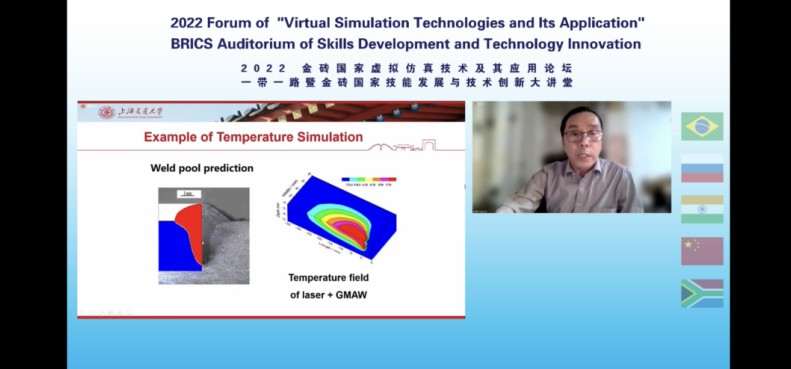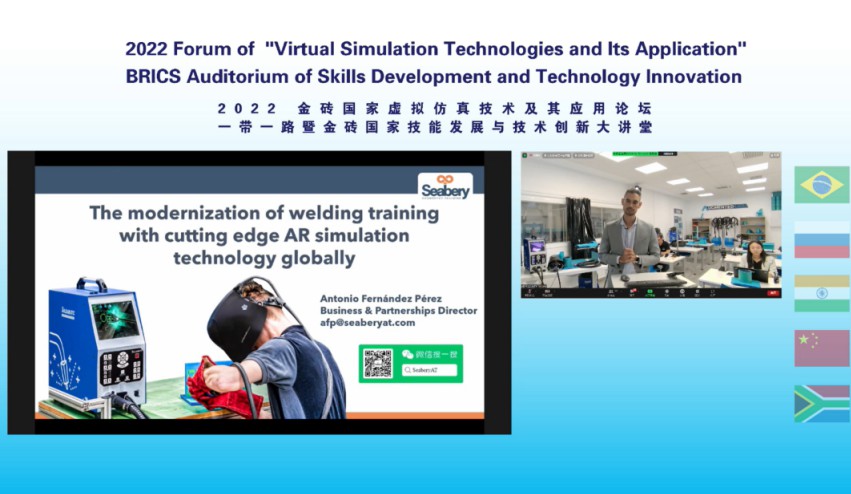
图:论坛现场
On July 5, the 2022 BRICS Virtual Simulation Technology and Its Application Forum was held in Xiamen. As the second installment of the 2022 Belt and Road and BRICS Skills Development and Technology Innovation Lecture Hall, the forum was held in a combination of online video and offline attendance.
嘉宾致辞

图:金砖国家工商理事会技能发展工作组主席、厦门市金砖未来技能发展与技术创新研究院院长刘振英博士致欢迎辞

图:金砖国家工商理事会(俄罗斯)技能发展工作组代表Anna Malinovskaya女士致辞

图:金砖国家工商理事会(印度)技能发展工作组代表Rajesh Pankaj博士致辞

图:金砖国家工商理事会(南非)技能发展工作组代表Sherrie Donaldson女士致辞

图:亚洲焊接协会会长Sze Thiam Siong在“虚拟仿真技术与焊接”专题致辞

图:金砖国家铸造业联合会主席、中国铸造协会会长张立波在“虚拟仿真技术与铸造”专题致辞

图:中国焊接协会副会长李连胜在“虚拟仿真技术与焊接”专题致辞

图:中国交通教育研究会副会长杨泽宇在“虚拟仿真技术与轨道车辆”专题致辞
Dr. Liu Zhenying, Chairman of BRICS Business Council Skills Development Working Group and President of BRICS Academy of Skills Development and Technological Innovation (Xiamen), attended the forum and delivered a welcome speech. Mr. Li Ming, Deputy Director of Xiamen BRICS New Industrial Revolution Partnership Innovation Base Construction Leading Group Office, attended the forum. Ms. Anna Malinovskaya, Representative of the Skill Development Working Group of BRICS Business Council (Russia), Dr. Rajesh Pankaj, Representative of the Skill Development Working Group of BRICS Business Council (India), Ms. Sherrie Donaldson, Representative of the Skill Development Working Group of BRICS Business Council (South Africa), President of Asian Welding Association (AWA) Sze Thiam Siong, Chairman of BRICS Foundry Federation and President of China Foundry Association Zhang Libo, Vice President of China Welding Association Li Liansheng, Vice President of China Transportation Education Research Association Yang Zeyu attended the forum and delivered speeches.
Leaders from Xiamen Torch Administrative Committee, Jimei District Industry and Information Bureau, and Xiamen Information Group were present on site. More than 200 people attended the meeting, including experts and scholars in related fields from BRICS countries, scientific researchers, technicians from enterprises, teachers and students from higher education institutions, and personnel from relevant units of BRICS innovation bases. About 122,000 people from 15 countries including BRICS, Singapore, Indonesia, Myanmar, Australia, Mauritius, Angola, Argentina, Lebanon, United Arab Emirates and South Korea watched the event online.

图:论坛线上会议室

图:四川省简阳市高级职业中学组织师生观看论坛直播
四个专题
With the theme of "Virtual Simulation technology and its application in basic industry", the forum was divided into four topics, inviting 9 university scholars and industry experts from China, Russia and Spain to make keynote presentations on the application of virtual simulation technology in industrial fields such as welding, casing and rail vehicles, as well as in remote distributed international training and competitions.
1.Virtual simulation and welding
The speakers focused on hot topics such as numerical simulation technology, AR simulation technology, and the application of virtual welding technology in large-scale talent training.

图:上海交通大学船舶海洋与建筑工程学院教授、博士生导师罗宇围绕“数值模拟及其在焊接领域的应用”做主旨报告
Luo Yu, professor and doctoral supervisor of the School of Shipbuilding, Oceanic and Architectural Engineering, Shanghai Jiaotong University, introduced the positive effect of numerical simulation on the study of welding mechanics through application examples, compared and analyzed the differences between numerical simulation and visual simulation, and discussed the common methods of welding mechanics simulation with domestic and foreign guests.

图:西班牙Seabery Soluciones SL亚洲、中东、非洲业务总监Antonio Fernandez围绕“利用全球前沿的AR模拟技术实现焊接培训的现代化”做主旨报告
Antonio Fernandez, Business Director of Asia, Middle East and Africa of Seabery Soluciones SL, a Spanish company, put forward that welding accounts for nearly 25% of the GDP of the global industrial manufacturing industry, however, the existing education system, human resources can not meet the needs of industrial development, and there is still a great shortage of senior welding personnel, how to apply advanced technology to promote vocational education and transformation is the urgent issue for the whole industry and education sector. How to apply advanced technology to promote vocational education and attract the young generation to study and engage in the welding profession is an urgent problem for the whole industry and the education sector, and we hope that through this forum, we can communicate and discuss with people from all walks of life in the BRICS countries and carry out pragmatic cooperation.

图:天津大学焊接专业博士、教授、博士生导师李桓围绕“虚拟焊接技术在大规模人才培养中的应用”做主旨报告
Li Huan, PhD, professor and doctoral supervisor of welding at Tianjin University, pointed out that the development potential of China's welding engineering is huge and the welding industry is full of talents by citing the Bird's Nest Project and the Hong Kong-Zhuhai-Macao Bridge Project, which won the International Welding Society's Welding Engineering Award, and he believed that the scientific cultivation mode and advanced training technology will help the welding vocational education to achieve better results.
2.Virtual Simulation and Casting
The speakers focused on casing computer simulation technology, digital twin technology in metallurgical process application.

图:华中科技大学二级教授、博士生导师周建新围绕“铸造计算机模拟仿真技术及应用”做主旨报告
Zhou Jianxin, second-level professor and doctoral supervisor of Huazhong University of Science and Technology, stressed that casing computer simulation technology is an important means to improve the quality of casing and casing forming technology level, which can realize the process optimization of casing forming manufacturing process, predict the organization, performance and service life of casing, ensure the quality of parts, significantly shorten the product development cycle and reduce production costs. And save a lot of resources and energy. Therefore, it is very important to increase the scientific research investment in this technology.

图:俄罗斯马格尼托大学材料加工技术系副教授Sergey Levandovsky围绕“数字孪生技术作为提高冶金工艺流程效率的先进方法”做主旨报告
Sergey Levandovsky, Associate Professor, Department of Materials Processing Technology, Magnitogorsk University, Russia, gave a keynote speech on the topic of "Digital Twin Technology as an Advanced Method to Improve the Efficiency of Metallurgical Processes", introducing the current status of the development of this technology and analyzing the important role of this technology in metallurgical production with the help of typical application cases.
3. Virtual Simulation and Rail Vehicles
The keynote speakers elaborated on rail transportation technology, the development of vocational education system and talent cultivation, which is a common concern around the world.

图:俄罗斯轨道车辆技术首席专家Gleb Zakharenko围绕“俄罗斯轨道车辆技术的形成”做主旨报告
Gleb Zakharenko, the chief expert of Russian rail vehicle technology, introduced the development history of Russian rail vehicle technology, analyzed the advantages and weaknesses of the existing technology, and exchanged ideas with the guests.

图:华中科技大学二级教授、博士生导师刘志明围绕“虚拟仿真技术在轨道交通职业教育国际化的应用”做主旨报告
Liu Zhiming, the project manager of the rail vehicle technology of the 46th WorldSkills Competition and the second-level professor of the rail vehicle Department of the Mechanical and Electronic Control Engineering School of Beijing Jiaotong University, said that virtual simulation technology solves the "three high and three difficult" pain points of "high investment, high loss, high risk" and "difficult to implement, difficult to observe, difficult to reproduce" in the process of practical training and teaching of rail vehicles. To promote the high quality development of modern vocational education.

图:第 46 届世界技能大赛轨道车辆技术中国技术专家组组长罗昭强围绕“虚拟仿真技术促进全球轨道交通人才均衡培养”做主旨报告
Luo Zhaoqiang, the head of China Technical Expert Group for Rail Vehicle Technology of the 46th World Skills Competition and a senior engineer, pointed out that the application of virtual simulation technology removes the limitations and lowers the thresholds for the cultivation of rail transportation talents, so that more regions, especially some underdeveloped countries and regions such as Asia, Africa, Latin America, and a wider range of groups of rail transportation practitioners can have access to high-quality education and training resources, and creates the opportunity of excellence in life for more skilled talents, and contributes to the balanced development of the vocational education and training of the global rail transportation.
4.Virtual Simulation and International Training and Competitions
Dr. Liu Zhenying said that in the post epidemic era, international communication and skills training are deeply affected, and virtual simulation technology realizes a high degree of matching between offline competition and online competition mode, relying on remote distributed cluster deployment, playing online competition features, building a three-dimensional digital competition environment consistent with the actual, providing the same competition conditions for both domestic and foreign competitors, and constructing a standardized, normative, efficient, and facilitated competition system, which is the best practice of virtual simulation technology to assist the remote distributed international training and competition.

图:刘振英博士以“虚拟仿真技术助力远程分布式国际培训及竞赛”为主题做主旨报告
The forum was hosted by BRICS Business Council Skills Development Working Group, the Innovation Base of the BRICS New Industrial Revolution Partnership, the Belt and Road and BRICS Skills Development International Alliance, and the Belt and Road and BRICS Skills Development and Technological Innovation Training Center of the China Association for Science and Technology. It is jointly sponsored by China Welding Association, China Transportation Education Research Association, China Foundry Association, Asian Welding Federation Technical Committee, and hosted by Xiamen BRICS Future Skills Development and Technology Innovation Research Institute, Xiamen Information Group Co., LTD.
Long-term mechanism
This forum is a series of activities under the long-term mechanism of the "Belt and Road and BRICS Auditorium of Skills Development and Technological Innovation", and is also the second international forum jointly organized by the Skills Development Working Group of the BRICS Business Council and the BRICS Innovation Base. Since its opening, the BRICS Lecture Hall has been widely praised by the academic and business communities of Brazil, Russia, India, China, South Africa, as well as "BRICS +" countries.
Focusing on the cutting-edge dynamics of the future skills industry, the BRICS Auditorium regularly plans and selects training themes around key professional fields of concern to BRICS countries, such as Industry 4.0, intelligent manufacturing, industrial Internet, blockchain, artificial intelligence, big data, etc., and shares the advanced technological achievements of the industry, builds a platform for exchanges and cooperation between schools and enterprises in BRICS countries, gives full play to its role as the main force in cultivating future skilled talents, and helps to enhance the competitiveness of the future skills of BRICS+ countries. "It will give full play to its role as the main force for training future skilled talents, help improve the competitiveness of future skills of BRICS+ countries, accelerate the construction of a high-quality human resources industrial system, and add to the achievements of the construction of BRICS innovation bases.
Written by Snow
Photo by Snow
Edited by Snow
Reviewed by He Wei
Related Reading
推荐文章




热门文章



 闽ICP备12331232468号-1
闽ICP备12331232468号-1